

Learn More About the Latest Major VxRail Software Release: VxRail 7.0.480
Tue, 24 Oct 2023 15:51:48 -0000
|Read Time: 0 minutes
Happy Autumn, VxRail customers! As the morning air gets chillier and the sun rises later, this blog on our latest software release – VxRail 7.0.480 – paired with your Pumpkin Spice Latte will give you the boost you need to kick start your day. It may not be as tasty as freshly made cider donuts, but this software release has significant additions to the VxRail lifecycle management experience that can surely excite everyone.
VxRail 7.0.480 provides support for VMware ESXi 7.0 Update U3o and VMware vCenter 7.0 Update U3o. All existing platforms that support VxRail 7.0, except ones based on Dell PowerEdge 13th Generation platforms, can upgrade to VxRail 7.0.480. This includes the VxRail systems based on PowerEdge 16th Generation platforms that were released in August.
Read on for a deep dive into the VxRail Lifecycle Management (LCM) features and enhancements in this latest VxRail release. For a more comprehensive rundown of the features and enhancements in VxRail 7.0.480, see the release notes.
Improving update planning activities for unconnected clusters or clusters with limited connectivity
VxRail 7.0.450, released earlier this year, provided significant improvements to update planning activities in a major effort to streamline administrative work and increase cluster update success rates. Enhancements to the cluster pre-update health check and the introduction of the update advisor report were designed to drive even more simplicity to your update planning activities. By having VxRail Manager automatically run the update advisor report, inclusive of the pre-update health check, every 24 hours against the latest information, you will always have an up-to-date report to determine your cluster’s readiness to upgrade to the latest VxRail software version.
If you are not familiar with the LCM capabilities added in VxRail 7.0.450, you can review this blog for more information.
VxRail 7.0.450 offered a seamless path for clusters that are connected to the Dell cloud to take advantage of these new capabilities. Internet-connected clusters can automatically download LCM pre-checks and the installer metadata files, which provide the manifest information about the latest VxRail software version, from the Dell cloud. The ability to periodically scan the Dell cloud for the latest files ensures the update advisor report is always up to date to support your decision-making.
While unconnected clusters could use these features, the user experience in VxRail 7.0.450 made it more cumbersome for users to upload the latest LCM pre-checks and installer metadata files. VxRail 7.0.480 aims to improve the user experience for those who have clusters deployed in dark or remote sites that have limited network connectivity.
Starting in VxRail 7.0.480, users of unconnected clusters will have an easier experience uploading the latest LCM pre-checks file onto VxRail Manager. The VxRail Manager UI has been enhanced, so you no longer have to upload via CLI.
Knowing that some clusters are deployed in areas where network bandwidth is at a premium, the VxRail Manager UI has also been updated so that you only need to upload the installer metadata file to generate the update advisor report. In VxRail 7.0.450, users had to upload the full LCM bundle for the update advisor report. The difference in the payload size of greater than 10GB for a full LCM bundle versus a 50KB installer metadata file is a tremendous improvement for bandwidth-constrained clusters, eliminating a barrier to relying on the update advisor report as a standard cluster management practice. With VxRail 7.0.480, whether you have connected or unconnected clusters, these update planning features are easy to use and will help increase your cluster update success rates.
To accommodate these improvements, the Local Updates tab has been modified to support these new capabilities. There are now two sub-tabs underneath the Local Updates tab:
- The Update sub-tab represents the existing cluster update workflow where you would upload the full LCM bundle to generate the update advisor report and initiate the cluster update operation.
- The Plan and Update sub-tab is the recommended path which incorporates the enhancements in VxRail 7.0.480. Here you can upload the latest LCM pre-checks file and the installer metadata file that you found and downloaded from the Dell Support website. Uploading the LCM pre-checks file is optional to create a new report because there may not always be an updated file to apply. However, you do need to upload an installer metadata file to generate a new report from here. Once uploaded, VxRail Manager will generate an update advisor report against that installer metadata file every 24 hours.
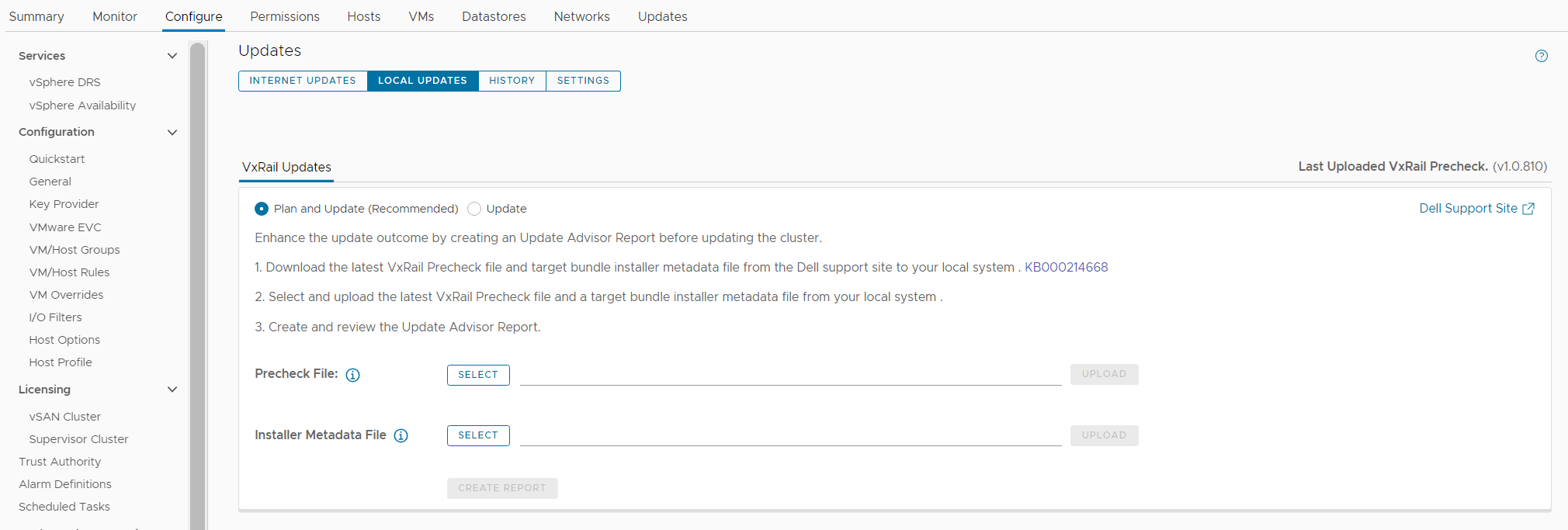
Figure 1. New look to the Local Updates tab
Easier record-keeping for compliance drift and update advisor reports
VxRail 7.0.480 adds new functionality to make the compliance drift reports exportable to outside the VxRail Manager UI while also introducing a history tab to access past update advisor reports.
Some of you use the contents of the compliance drift report to build out a larger infrastructure status report for information sharing across your organizations. Making the report exportable would simplify that report building process. When exporting the report, there is an option to group the information by host if you prefer.
Note that the compliance check functionality has moved from the Compliance tab under the Updates page to a separate page, which you can navigate to by selecting Compliance from under the VxRail section.
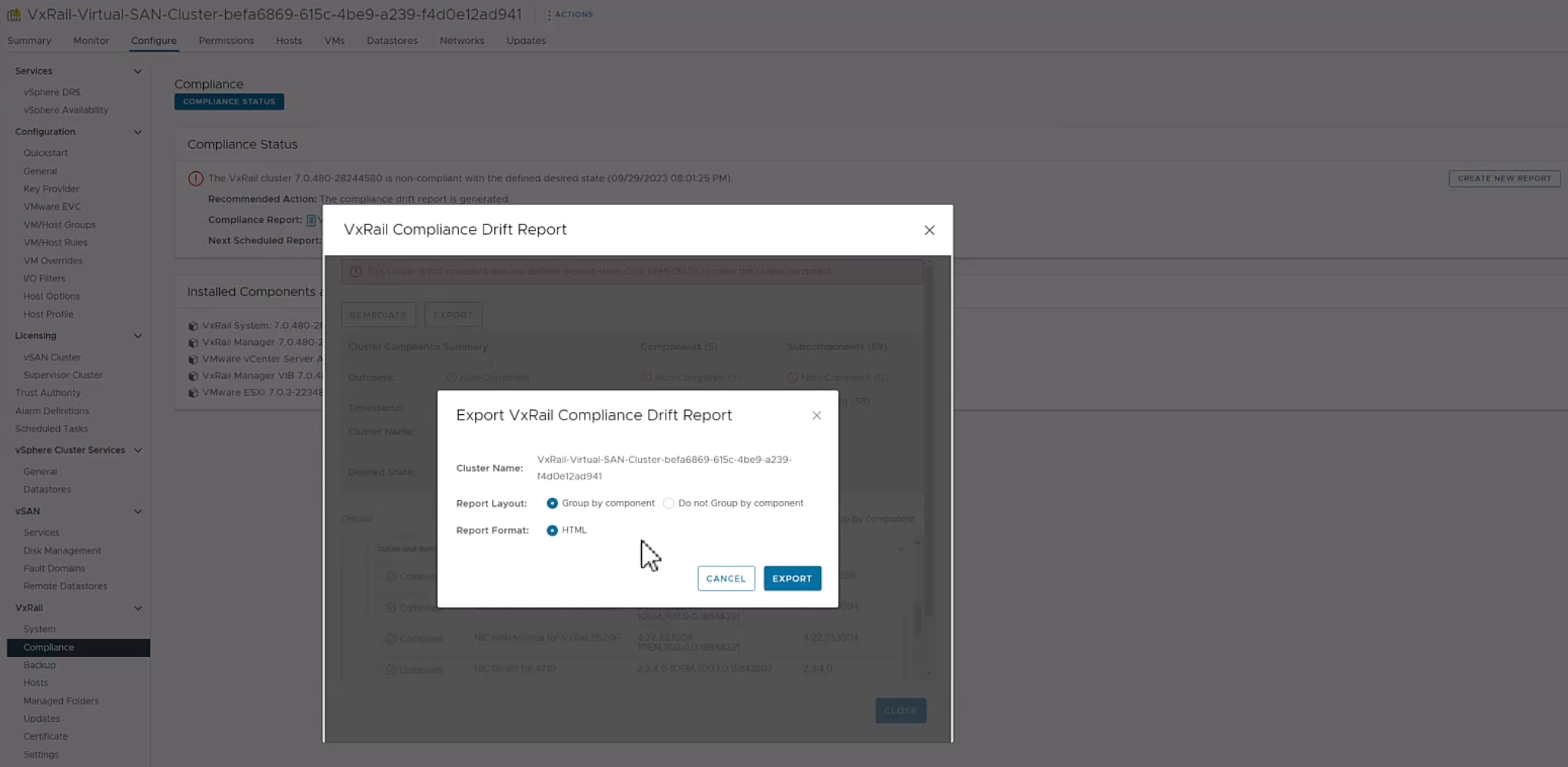
Figure 2. Exporting the compliance drift report
The exit of the Compliance tab comes with the introduction of the History tab on the Updates page in VxRail 7.0.480. Because VxRail Manager automatically generates a new update advisor report every 24 hours and you have the option to generate one on-demand, the update advisor report is often overwritten. To avoid the need to constantly export them as a form of record-keeping, the new History tab stores the last 30 update advisor reports. The reports are listed in a table format where you can see which target version the report was run against and when it was run. To view the full report, you can click on the icon on the left-hand column.
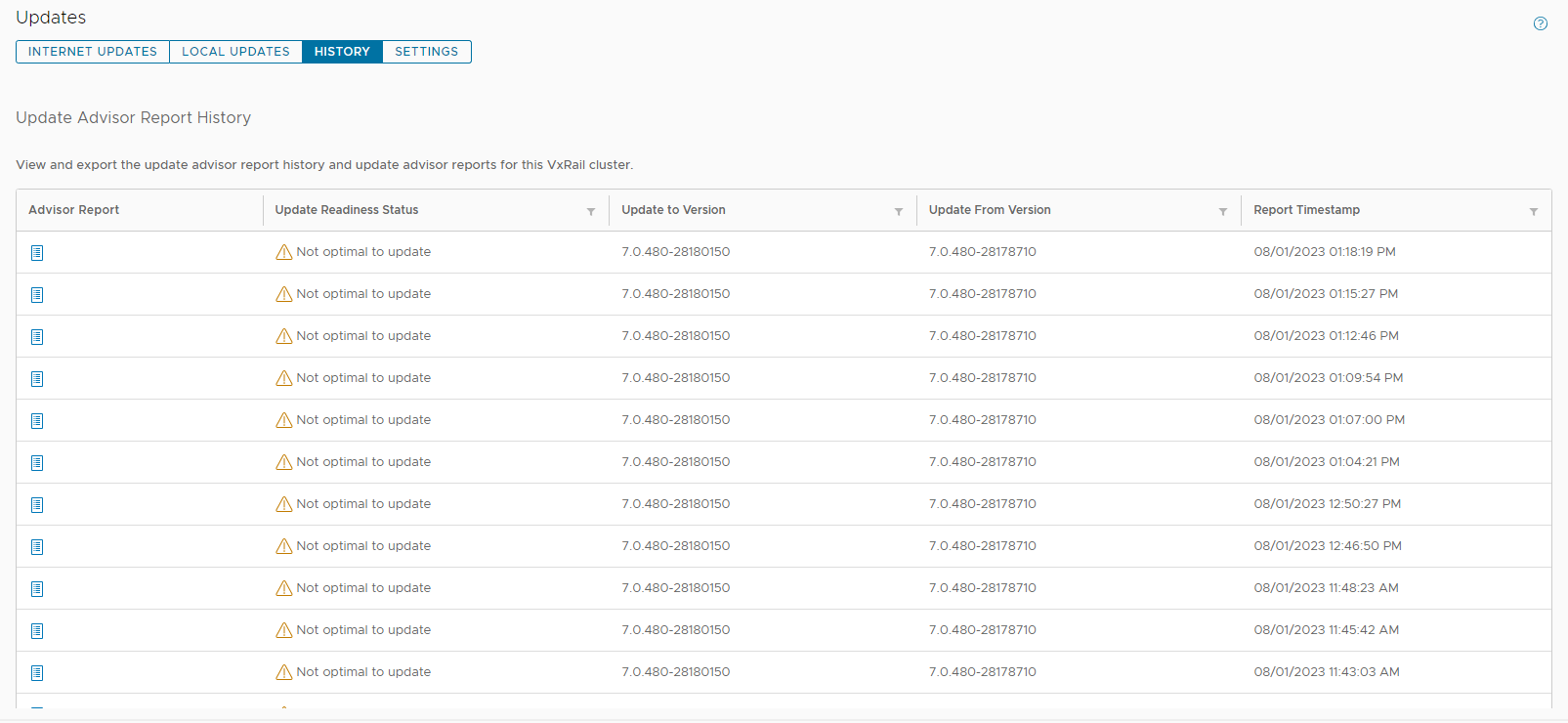
Figure 3. New History tab to store the last 30 update advisor reports
Addressing cluster update challenges for larger-sized clusters
For some of you that have larger-sized clusters, cluster updates pose challenges that may prevent you from upgrading more frequently. For example, the length of the maintenance window required to complete a full cluster update may not fit within your normal business operations such that any cluster update activity will impact service availability. As a result, cluster updates are kept to a minimum and nodes inevitably are not rebooted for long periods of time. While the cluster pre-update health check is an effective tool to determine cluster readiness for an upgrade, some issues may be lurking that a node reboot can uncover. That’s why some of you script your own node reboot sequence that acts as a test run for a cluster upgrade. The script reboots each node one at a time to ensure service levels of your workloads are maintained. If any nodes fail to reboot, you can investigate those nodes.
VxRail 7.0.480 introduces the node reboot sequence on VxRail Manager UI so that you do not have to manage your scripts anymore. The new feature includes cluster-level and node-level prechecks to ensure it is safe to perform this activity. If nodes fail to reboot, there is an option for you to retry the reboot or skip it. Making this activity easy may also encourage more customers to do this additional pre-check before upgrading their clusters.

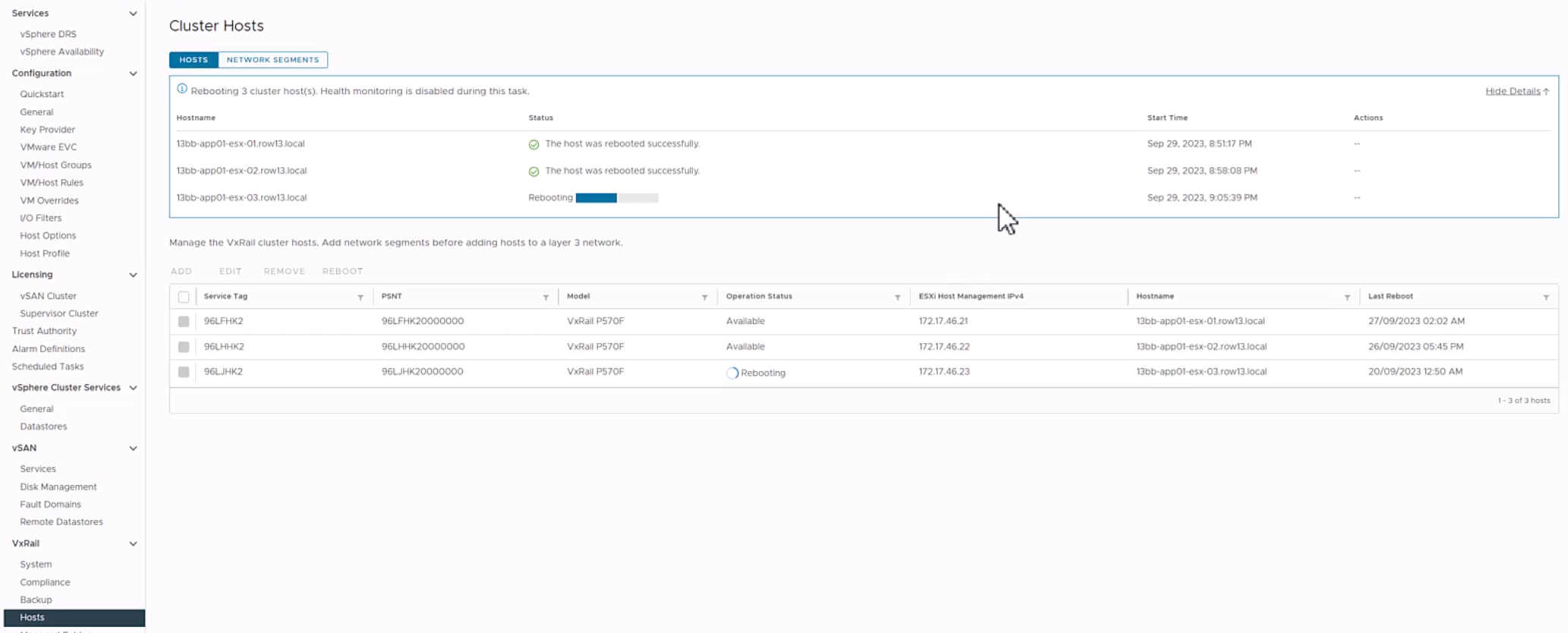
Figure 5. Monitoring the node reboot sequence on the dashboard
VxRail 7.0.480 also provides the capability to split your cluster update into multiple parts. Doing so allows you to separate your cluster upgrade into smaller maintenance windows and work around your business operation needs. Though this capability could reduce the impact of a cluster upgrade to your organization, VMware does recommend that you complete the full upgrade within one week given that there are some Day 2 operations that are disabled while the cluster is partially upgraded. VxRail enables this capability only through VxRail API. When a cluster is in a partially upgraded state, features in the Updates tab are disabled and a banner appears alerting you of the cluster state. Cluster expansion and node removal operations are also unavailable in this scenario.
Conclusion
The new lifecycle management capabilities added to VxRail 7.0.480 are part of the continual evolution of the VxRail LCM experience. They also represent how we value your feedback on how to improve the product and our dedication to making your suggestions come to fruition. The LCM capabilities added to this software release will drive more effective cluster update planning, which will result in higher rates of cluster update success that will drive more efficiencies in your IT operations. Though this blog focuses on the improvements in lifecycle management, please refer to the release notes for VxRail 7.0.480 for a complete list of features and enhancements added to this release. For more information about VxRail in general, visit the Dell Technologies website.
Author: Daniel Chiu
Related Blog Posts

Learn About the Latest Major VxRail Software Release: VxRail 7.0.450
Thu, 11 May 2023 16:14:15 -0000
|Read Time: 0 minutes
To our many VxRail customers, you know that our innovation train is a constant machine that keeps on delivering more value while keeping you on a continuously validated track. The next stop on your VxRail journey brings you to VxRail 7.0.450 which offers significant benefits to life cycle management and dynamic node clusters.
VxRail 7.0.450 provides support for VMware ESXi 7.0 Update 3l and VMware vCenter 7.0 Update 3l. All existing platforms that support VxRail 7.0 can update to 7.0.450.
This blog provides a deep dive into some of the life cycle management enhancements as well as PowerStore Life Cycle Management integration into VxRail Manager for VxRail dynamic node clusters. For a more comprehensive rundown of the features introduced in this release, see the release notes.
Life cycle management
The life cycle management features that I am covering can provide the most impact to our VxRail customers. The first set of features are designed to offer you actionable information at your fingertips. Imagine taking your first sip of coffee or tea as you log onto VxRail Manager at the start of your day, and you immediately have all the up-to-date information that you need to make decisions and plan out your work.
VxRail pre-update health check
The VxRail pre-update health check, or pre-check as the VxRail Manager UI refers to it, has been an important tool for you to determine the overall health of your clusters and assess the readiness for a cluster update. The output of this report brings helps you to be aware of troublesome areas and provides you with information, such as Knowledge Base articles, to resolve the issues. This tool relies on a script that can be automatically uploaded onto the VxRail Manager VM, if the cluster is securely connected to the Dell cloud, or manually uploaded as a bundle procured from the Dell Support website.
For the health check to stay reliable and improve over time, the development of the health check script needs to incorporate a continuous feedback loop so that the script can easily evolve. Feedback can come from our Dell Services and escalation engineering teams as they learn from support cases, and from the engineering team as new capabilities and additions are introduced to the VxRail offering.
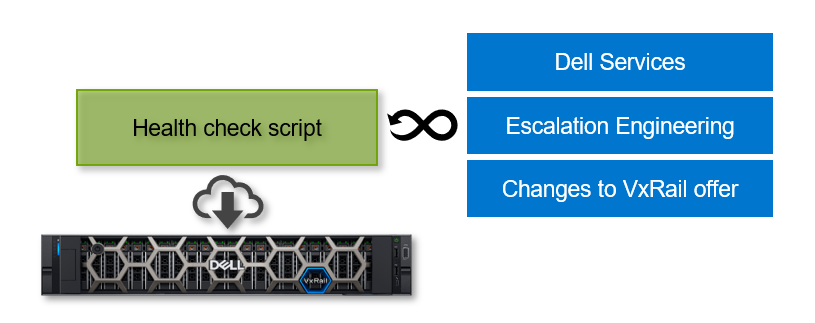
To provide an even more accurate assessment of the cluster health and readiness for a cluster update, the VxRail team has increased the frequency of how often the health check script is updated. Starting with VxRail 7.0.450, clusters that are connected to the Dell cloud will automatically scan for new health check scripts multiple times per day. The health check will automatically run every 24 hours, with the latest script in hand, so that you will have an up-to-date report ready for your review whenever you log onto VxRail Manager. This enhancement has just made the pre-update health check even more reliable and convenient.
For clusters that are not connected to the Dell cloud, you can still benefit from the increased frequency of health script updates. However, you are responsible for checking for any updates on the Dell Support website, downloading them, and staging the script on VxRail Manager for the tool to utilize it.
VxRail cluster update planning
The next enhancement that I will delve into provides a simpler and more convenient cluster update planning experience. VxRail 7.0.450 introduces more automation into the cluster update planning operations, so that you have all the information that you need to plan for an update without manual intervention.
For a cluster connected to the Dell cloud, VxRail Manager will automatically scan for new update paths that are relevant to that particular cluster. This scan happens multiple times a day. If a new update path is found, VxRail Manager will download the lightweight manifest file from that target LCM composite bundle. This file provides the metadata of the LCM composite bundle, including the manifest of the target VxRail Continuously Validated State.
The following figure shows the information of two update paths provided by their manifest files to populate the Internet Updates tab. That information includes the target VxRail software version, estimated cluster update time, link to the release notes, and whether reboots are required for the nodes to complete an update to this target version. (You can disregard the actual software version numbers: these are engineering test builds used to demonstrate the new functionality.)

VxRail Manager, by default, will recommend the next software version on the same software train. For the recommended path, VxRail Manager automatically generates an update advisor report which is the new feature for cluster update planning. An update advisor report is a singular exportable report that consolidates the output from existing planning tools:
- Same metadata of the update path, as provided on the Internet Updates tab:
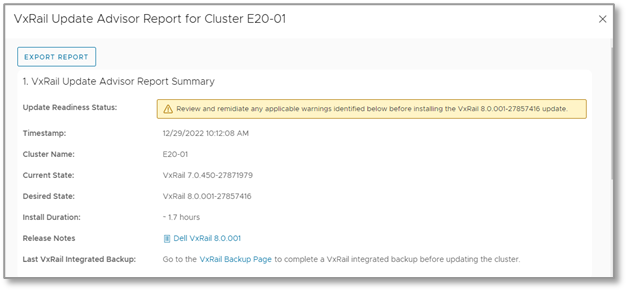
- The update advisory report that provides component-by-component change analysis, which helps users build IT infrastructure change reports:
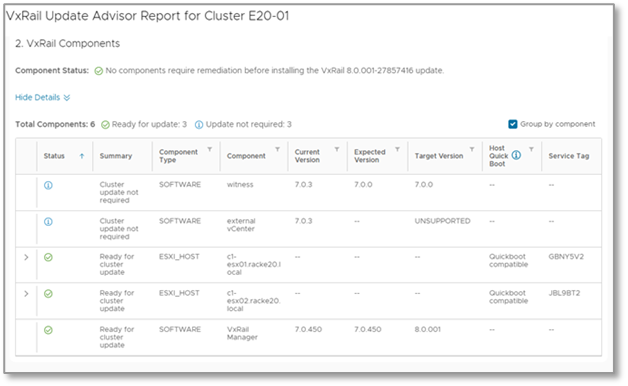
- The health check report that was discussed earlier:
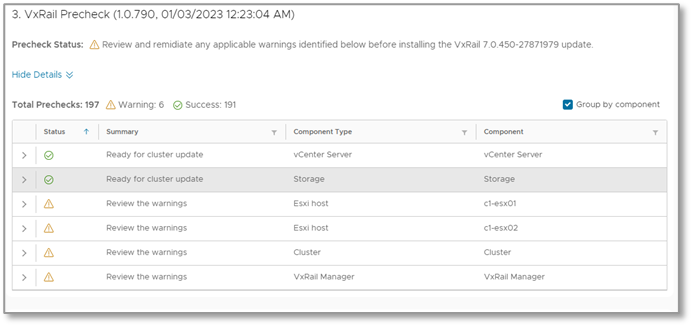
- The user-managed component report that reminds users whether they need to update non-VxRail managed components for a cluster update:

This report is automatically generated every 24 hours so that you can log onto VxRail Manager and have all the up-to-date information at your disposal to make informed decisions. This feature will make your life easier because you no longer have to manually run all these jobs and wait for them to complete!
For a non-recommended update, you can manually generate an update advisor report using the Actions button for the listed update path. For clusters not connected to Dell cloud, you can still benefit from the update advisor report. However, instead of downloading a lightweight manifest file, you would have to download the full LCM bundle from the Dell Support website to generate the report.
Smart bundle
The last life cycle management feature that I want to focus on is about smart bundles. The term ‘smart bundle’ refers to a space-efficient LCM bundle that can be downloaded from the Dell cloud. For VxRail users who are using CloudIQ today to manage their VxRail clusters, this feature is familiar to you. A space-efficient bundle is created by first performing a change analysis of the VxRail Continuously Validated State currently running on a cluster versus the target VxRail Continuously Validated State that a user wants to download for their cluster. The change analysis determines the delta of install files in the full LCM bundle that is needed by the cluster to download and update to the target version.
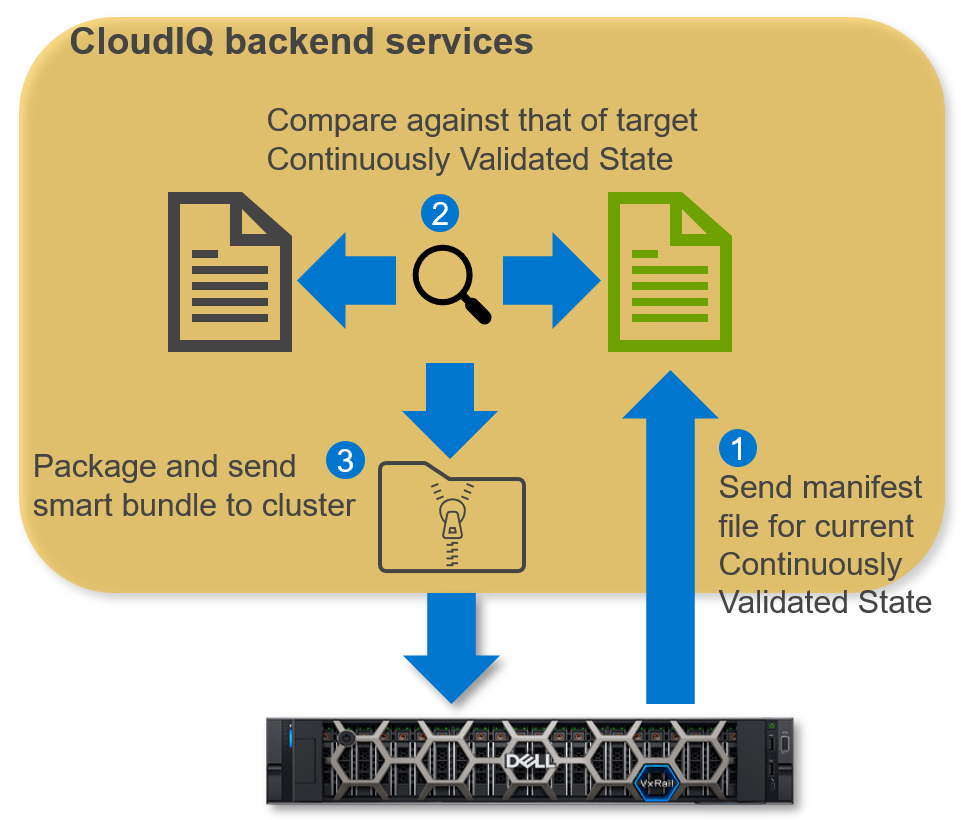
In VxRail 7.0.450, you can now initiate smart bundle transfers from VxRail Manager. Smart bundles can greatly reduce the transfer size of an update bundle, which can be extremely beneficial for bandwidth-constrained environments. To use the smart bundle feature, the cluster has to be configured to connect to CloudIQ in the Dell cloud. If VxRail Manager is not properly configured to use the smart bundle feature or if the smart bundle operation fails, VxRail Manager defaults to using the traditional method of downloading the full LCM bundle from the Dell cloud.
VxRail dynamic nodes with PowerStore
VxRail 7.0.450 introduces the much-anticipated integration of PowerStore life cycle management into VxRail Manager for a configuration consisting of VxRail dynamic nodes using PowerStore as the primary storage (also referred to as Dynamic AppsON). This integration further centralizes PowerStore management onto the vCenter Server console for VMware environments. With the Virtual Storage Integrator (VSI) plugin to vCenter, you have been able to provision PowerStore storage and manage data services. Now, you can use the VxRail Manager plugin to manage a PowerStore update and view the array’s software version.
To enable this functionality, VxRail leverages the VSI’s new API server to communicate with the PowerStore Manager and initiate lifecycle management operations and retrieve status information. The API server was developed exclusively for VxRail Manager in a Dynamic AppsON configuration. You start the LCM workflow by first uploading the update bundle to PowerStore Manager, then running an update pre-check, and lastly running the update. The operations are initiated from VxRail Manager but the actual operations are executed on the PowerStore Manager.
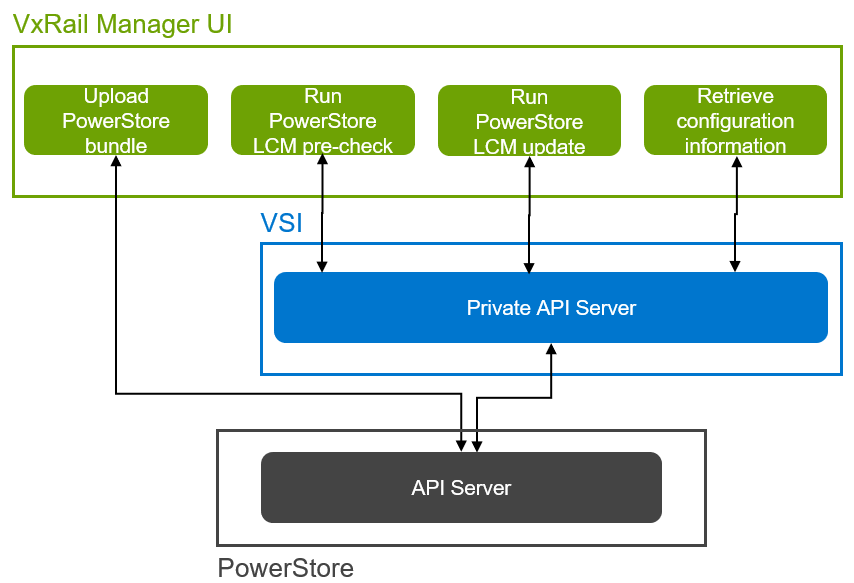
The following video shows the PowerStore LCM workflow that can be run from the VxRail Manager. You can update a PowerStore that is using any storage type, except NFS, as the primary storage for a VxRail dynamic node cluster.
Conclusion
Although VxRail 7.0.450 is a jam packed release with many new features and enhancements, the features I’ve described are the headliners and deserve a deeper dive to unpack the capability set. Overall, the set of LCM enhancements in this release provides immense value for your future cluster management and update experience. For the full list of features introduced in this release, see the release notes. And for more information about VxRail in general, check out the Dell VxRail Hyperconverged Infrastructure page on www.dell.com.
Author: Daniel Chiu

Impacting the World, One Happy Customer at a Time
Fri, 25 Aug 2023 21:45:55 -0000
|Read Time: 0 minutes
As I get back from a lovely week to relax and reset by the beach in Mauritius, I have had time to realize that sometimes the important thing to do is to find time to relax and rejuvenate. I have come back with a burst of energy ready to get back to doing what I love most – spending time helping customers build simple Infrastructure solutions.
As a core member of the Dell Technologies infrastructure solutions sales team, I have come to realize that our core job is to solve problems. All businesses today are out there solving customer problems and challenges, either by producing goods or delivering services. Most businesses today have a lot of behind-the-scenes challenges to overcome to be able to help their customers.
 Technology plays a big part in everything we do today, and IT teams must be on top of their game all the time to ensure businesses can continue to focus on what’s important – Customers!
Technology plays a big part in everything we do today, and IT teams must be on top of their game all the time to ensure businesses can continue to focus on what’s important – Customers!
I have had the opportunity to work with a non-profit organization that is literally making the world a better place for everyone globally. The work they do is non-stop and it is not easy. Their work requires an immaculate IT setup that needs to be always online, secure, and able to scale for their bespoke applications. Their current setup has gone through some major changes in terms of their applications and tracking methodologies. They had been experiencing multiple information and data silos, complexity in infrastructure management, and data security issues. In helping them find a way to simplify their IT, we too played a part in making the world a better place.
We had a few conversations and agreed that we needed to build the entire infrastructure on one platform. In this case, VMware was the unanimous choice. The two biggest challenges were to eliminate silos and to simplify management. HCI was the best way to achieve both, and we chose VxRail HCI systems. This solution went on to deliver a consistent platform across the edge, core, and cloud. It has proven to be a solution that can that manage all of the compute, storage, and networking resources through a single pane of glass with vCenter -- all under a single support umbrella for all of the hardware and software deployed.
Lifecycle management with BIOS, firmware, and software updates and upgrades can be a painful and time-consuming process. But what if I told you we can automate these tasks with one-click upgrades, one node at a time without any downtime – how does that sound? When I asked, the CTO was happy, and the IT manager was happier. All those investments in our R&D labs with over 100 people working on resolving some of the most common challenges -- like upgrades for IT teams around the world -- now made sense.
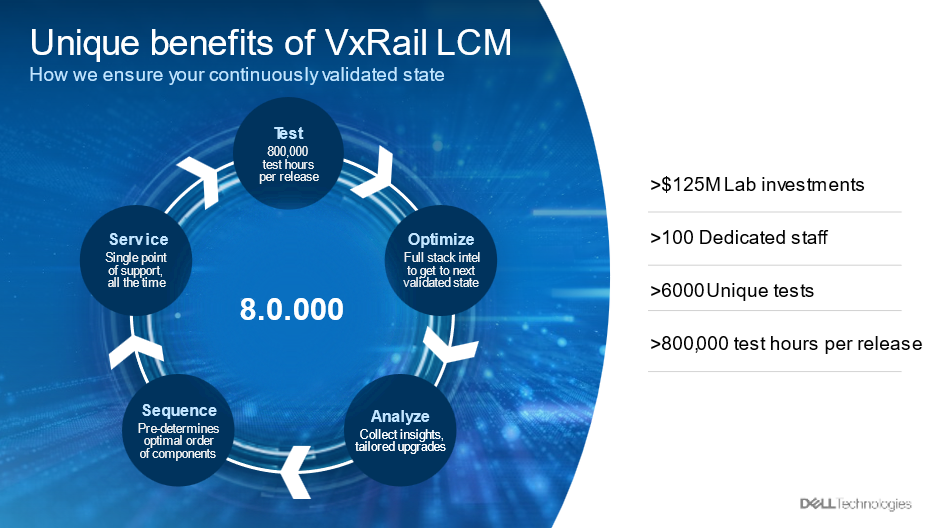
What made the solution choice easier was the ability to remotely monitor it from anywhere in the world with Cloud IQ, and its ability to scale and grow, not just on premises but in the cloud, any cloud at any time.
Did we manage to resolve their IT challenges - Yes, with a simplified solution like VxRail that provides performance, management simplicity, automation of tasks, and the flexibility to grow and scale. The customer was delighted - knowing full well that they now have an infrastructure setup that helps them do all the work they do consistently, and to be able to expand their work to different Geo Regions as well.
At the end of it all did I enjoy my time off after helping build an infrastructure solution for an organization doing something so meaningful. While I was away, I did get a postcard from the IT manager who was able take his wonderful family out for a nice little vacation, knowing that he could easily manage anything he needed to from anywhere in the world.
On to helping our next customer get the same peace of mind so they can leave their mark on the world too.
Author: Manish Bajaj


